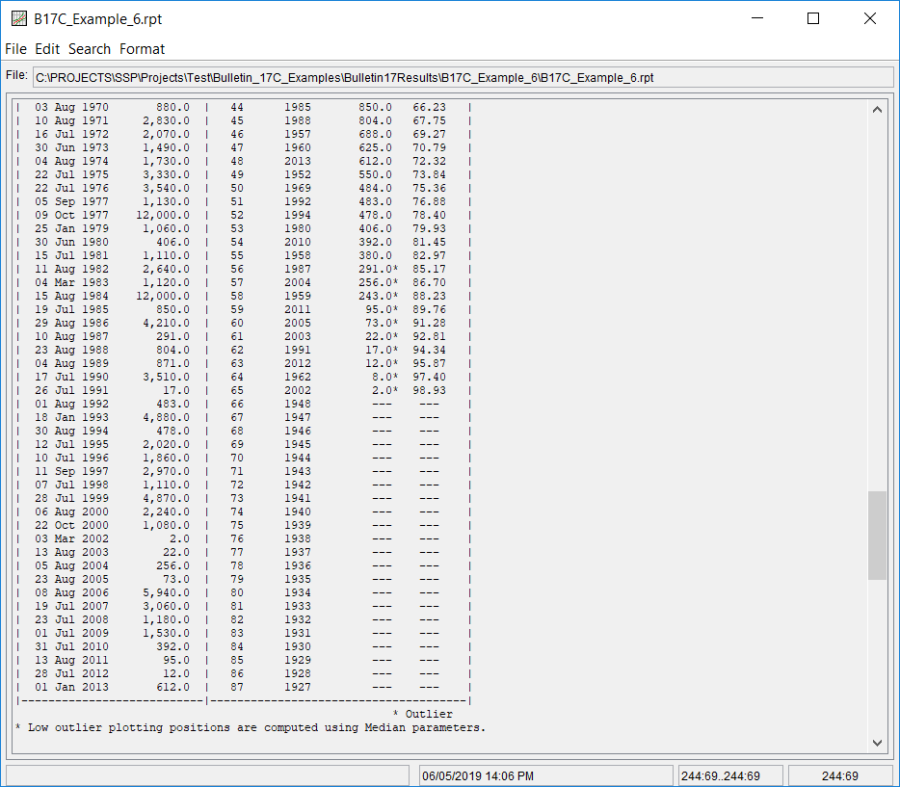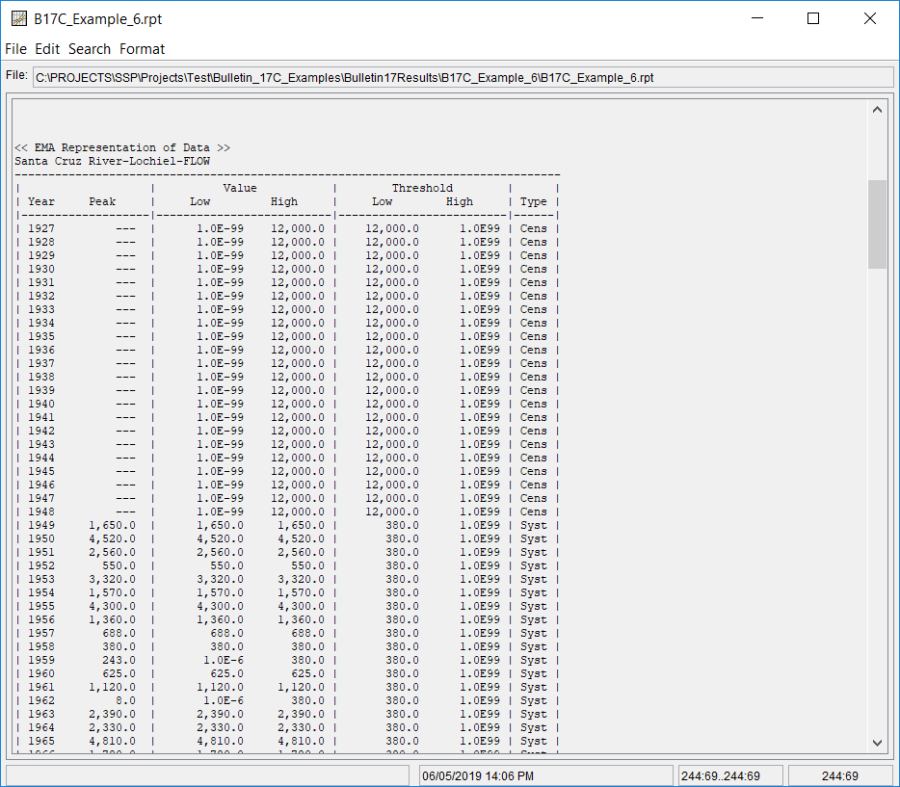Download PDF
Download page Example 6. Historic Data and Low Outliers – Santa Cruz River at Lochiel, AZ.
Example 6. Historic Data and Low Outliers – Santa Cruz River at Lochiel, AZ
Example 6 illustrates the computation of a peak flow frequency curve using EMA and Bulletin 17C procedures with an annual maximum series comprised of systematic data and historical flood information that can be used to extend the historical period. For this example, USGS gage 09480000 Santa Cruz River near Lochiel, AZ is used. The stream gage in question has an approximate 82.2 sq. mi. contributing watershed with an annual peak record consisting of 65 peaks beginning in water year 1949 and ending in water year 2013. A large flood event occurred on October 9, 1977. This flood is noted in the USGS Annual Water Data Report for this gage and there is historical information available for this large flood indicating that this flood is the largest since 1927 (Aldridge & Eychaner, 1984). Of the 65 annual peaks, the August 15, 1984 flood is equal to the October 1977 historic flood peak. Based on information contained within Aldridge and Eychaner (1984) for the October 1977 flood, this event can be used as a perception threshold to represent the 22 years of missing information from 1927 to 1946. The annual maximum series is plotted in Figure 1 and tabulated in Table 1.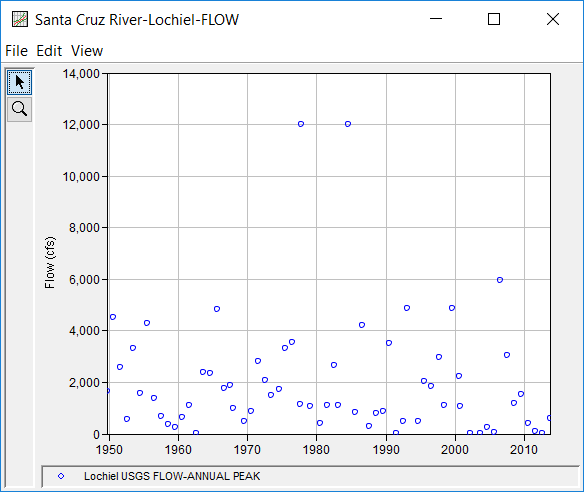
Table 1. Santa Cruz River at Lochiel, AZ Annual Peak Flow Record.
Date | Flow (cfs) |
|---|---|
13 Sep 1949 | 1650 |
30 Jul 1950 | 4520 |
02 Aug 1951 | 2560 |
16 Aug 1952 | 550 |
14 Jul 1953 | 3320 |
22 Jul 1954 | 1570 |
06 Aug 1955 | 4300 |
17 Jul 1956 | 1360 |
09 Aug 1957 | 688 |
07 Aug 1958 | 380 |
14 Aug 1959 | 243 |
30 Jul 1960 | 625 |
08 Aug 1961 | 1120 |
29 Jul 1962 | 8 |
25 Aug 1963 | 2390 |
09 Sep 1964 | 2330 |
12 Sep 1965 | 4810 |
18 Aug 1966 | 1780 |
03 Aug 1967 | 1870 |
20 Dec 1967 | 986 |
05 Aug 1969 | 484 |
03 Aug 1970 | 880 |
10 Aug 1971 | 2830 |
16 Jul 1972 | 2070 |
30 Jun 1973 | 1490 |
04 Aug 1974 | 1730 |
22 Jul 1975 | 3330 |
22 Jul 1976 | 3540 |
05 Sep 1977 | 1130 |
09 Oct 1977 | 12000 |
25 Jan 1979 | 1060 |
30 Jun 1980 | 406 |
15 Jul 1981 | 1110 |
11 Aug 1982 | 2640 |
04 Mar 1983 | 1120 |
15 Aug 1984 | 12000 |
19 Jul 1985 | 850 |
29 Aug 1986 | 4210 |
10 Aug 1987 | 291 |
23 Aug 1988 | 804 |
04 Aug 1989 | 871 |
17 Jul 1990 | 3510 |
26 Jul 1991 | 17 |
01 Aug 1992 | 483 |
18 Jan 1993 | 4880 |
30 Aug 1994 | 478 |
12 Jul 1995 | 2020 |
10 Jul 1996 | 1860 |
11 Sep 1997 | 2970 |
07 Jul 1998 | 1110 |
28 Jul 1999 | 4870 |
06 Aug 2000 | 2240 |
22 Oct 2000 | 1080 |
04 Mar 2002 | 2 |
14 Aug 2003 | 22 |
05 Aug 2004 | 256 |
23 Aug 2005 | 73 |
08 Aug 2006 | 5940 |
19 Jul 2007 | 3060 |
23 Jul 2008 | 1180 |
01 Jul 2009 | 1530 |
31 Jul 2010 | 392 |
13 Aug 2011 | 95 |
28 Jul 2012 | 12 |
08 Sep 2013 | 612 |
A Bulletin 17 Analysis using EMA and Bulletin 17C procedures has been developed for this example. To open the analysis, either double-click on the analysis labeled "B17C Example 6" from the Study Explorer or from the Analysis menu select open, then select "B17C Example 6" from the list of available analyses. When "B17C Example 6" is selected, the Bulletin 17 analysis editor will appear as shown in Figure 2. As shown, the Skew option was set to use the Station Skew.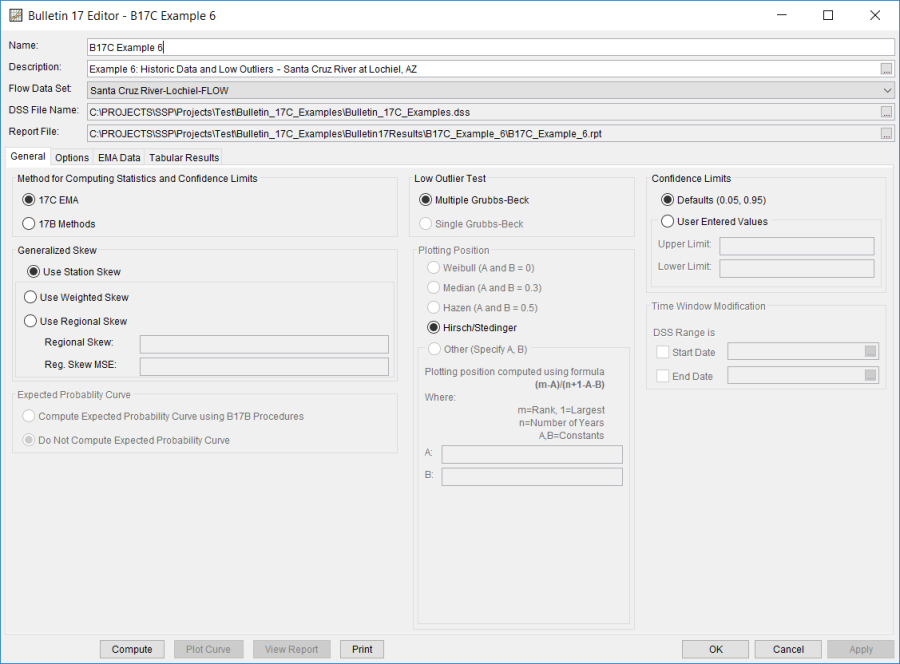
No changes to the Options tab are necessary. The EMA Data tab for this example is shown in Figure 3. This example uses an annual maximum series consisting of systematic data along with historical information. As was previously mentioned, historical information indicates that the October 1977 flood event was the largest since at least 1927. This information can be used within EMA to extend the historical period through the use of a perception threshold. Specifically, the first perception threshold should be modified to start at water year 1927. Then, a second perception threshold of 12000 – inf should be added for the period of missing data spanning water years 1927 through 1948, as shown in Figure 3. Once both perception thresholds have been entered, click the Apply Thresholds button to assign the complementary flow ranges for the periods of missing data. No further changes to the flow range table are necessary.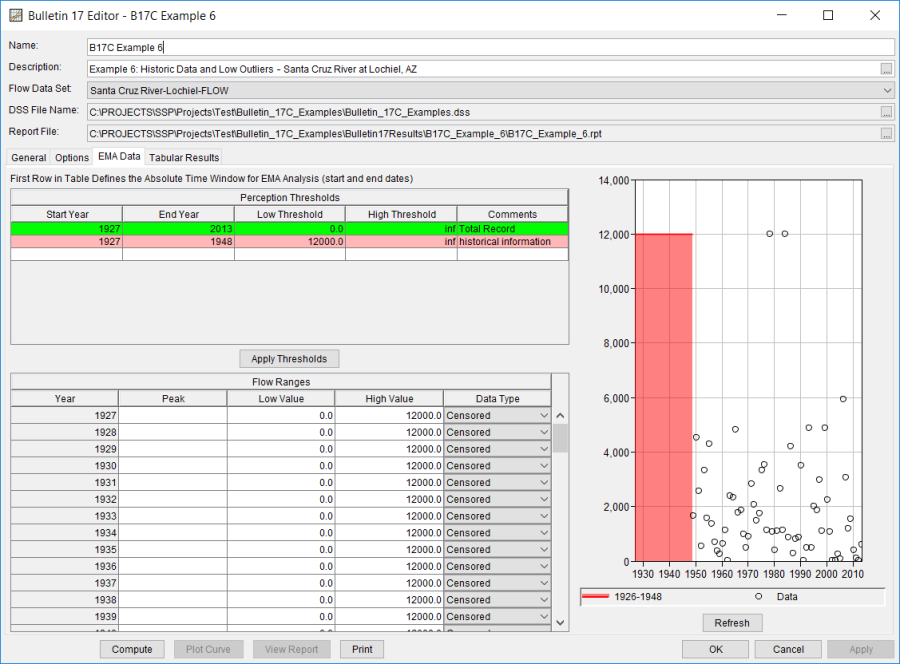
Once all of the General and EMA Data tab settings are set or selected, the user can press the Compute button to perform the analysis. Once the computations have been completed, a message window will open stating Compute Complete. Close this window and then select the Tabular Results tab. The analysis window should resemble Figure 4.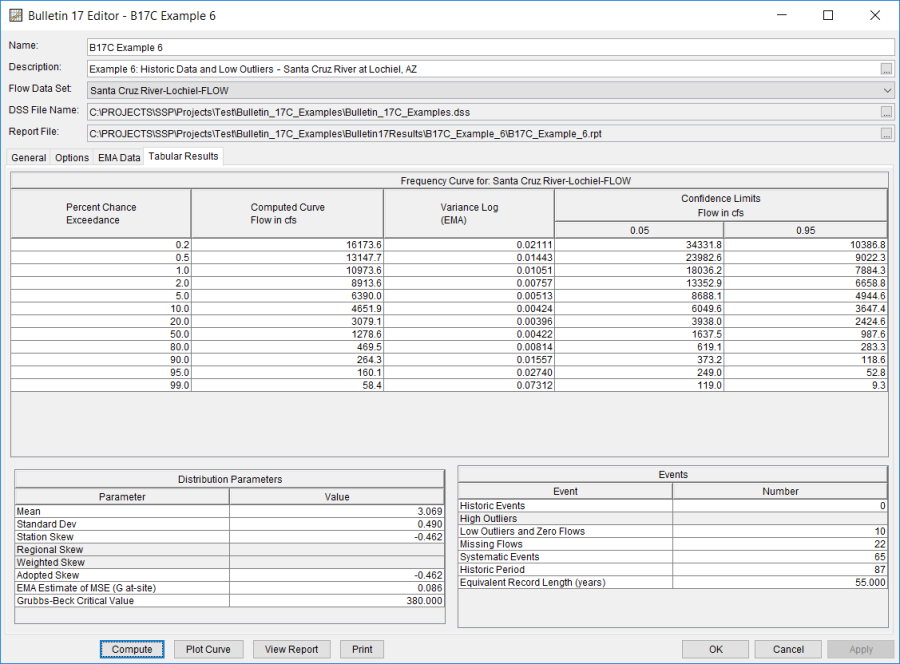
In addition to the tabular results, a graphical plot of the computed frequency curves can be obtained by pressing the Plot Curve button at the bottom of the analysis window. The Log Pearson Type III distribution fit using EMA to the input annual maximum flow data set, the 5% and 95% confidence limits, and the computed plotting positions are shown in Figure 5.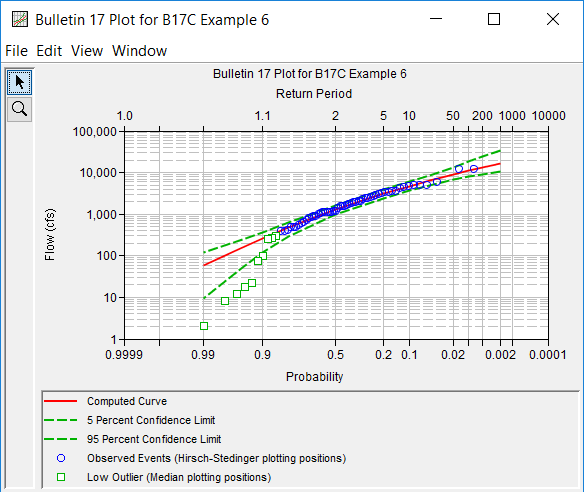
As shown in Figure 4, the Multiple Grubbs-Beck Test identified a low outlier threshold (critical value) of 380 cfs, which corresponds to the smallest peak that was retained. Ten annual peak flows were identified and censored, as shown in Figure 6. These annual peak flows were then recoded to have a flow interval of zero – 380. The perception thresholds for the years in which an annual peak flow was recorded were also adjusted to correspond with the Multiple Grubbs-Beck Test low outlier threshold (critical value). Consequently, these perception thresholds were changed from zero – inf to 380 – inf. The perception threshold for the years in which there is only historical nonexceedance data (i.e. 1927 – 1948) were left at 12,000 - inf, as shown in Figure 7.